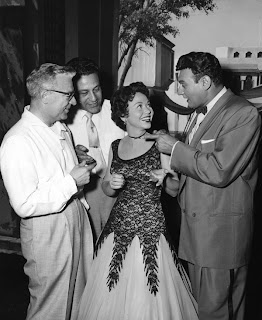First there was Marconi, then crystal sets, followed by New York City's WNEW with Martin Block. Then, here on Long Island there was a fellow, a former U.S. Marine Corps Combat Correspondent by the name of Jack Ellsworth, who started his disc jockey radio show "Memories in Melody" on radio station WALK in Patchogue and held rein for some thirty years.
Well, Top 40 stuff filtered therein and Jack, his wife Dot, and their Newscaster partner George Drake, picked up their 78's and started a new radio station called WLIM, also in Patchogue. They kept the same format of Big Band music and invited some big name visitors to the station, names like Larry Elgart, Ray Anthony, the great Benny Goodman ( who stayed all day) and the entire Glenn Miller Orchestra with Larry O'Brien. Jack had already interviewed Sinatra and Crosby earlier, and they both contributed soundies for the new station's promotions.
Upon Jack's 50th Anniversary in 1997 as a disc jockey, Sinatra wrote him, saying: "We've traveled many musical miles together, my friend. I am delighted to send cheers and bravos to you on 50 marvelous years of championing our kind of music.
"As I raise a glass of bubbly, I thank you for your generous support of my career --- you're a good man."
Back in 1941 Jack's story began:
"I received a phone call from popular jock Art Ford, who later had an all-night show on WNEW called the Milkman's Matinee. Art was running a Bing Crosby show on station WBNX in the Bronx, and he had heard I had a great Crosby record collection. He asked me to bring them up to his studio. I was a teenager and very impressionable. I was thrilled to be a radio show guest."
Jack became a frequent visitor on Art's show, talking about all the greats. Smitten with the radio bug while at Brown University in 1947, Jack hosted a show on campus, using his Art Ford credentials. There was no monetary compensation, but he thoroughly enjoyed spinning the 78s that so influenced his life.
" I applied for a disc jockey job with a station that had a WNEW style format and got the job. After three years of top ratings, I accepted a similar position at WVNJ in Newark, New Jersey, and in 1950 I heard about a station in Huntington, Long Island called WGSM, and obtained a similar job there. A year later I went to work for WALK.
Jack met his wife Dot in 1951 and married her in November. She had been a legal secretary. They settle in Bellport and he began work at WALK, and in 1963 was promoted to station manager. In 1975 he became President, General Manager and CEO.
In 1980 WALK was sold. Jack and George Drake's bid was outbid and so they started WLIM.
During his 30 years at WALK Jack interviewed many heavyweights like Doris Day, Dick Haymes, Les Paul and Mary Ford as well as Sinatra and Crosby, among others.
"There is a uniqueness in radio," Jack says, "When I put on Glenn's 'Moonlight Serenade,' I could cry from its solemn beauty. People can close their eyes and take themselves back in their life they first heard the classic tune. It's great therapy, and always pleasant listening, unlike the frenetic music of today."
Well, now Jack has been back at WALK, 1370 AM with his same show "Memories in Melody " for a few years now. I have spent some time with Jack on the air being interviewed for some of my books. One day I brought the one and only Jerry Vale to the station as a surprise for Jack while he was on the air. Well, he jumped up and hugged Jerry and turned the show over to him and his music. He had never met Jerry Vale, but had talked to him on the phone many times. It was a great reunion of sorts and everyone at the station was very happy to witness the meeting of two giants of music.
So, Jack is back home at WALK where he first started. Jack is over eighty now and you would never know it. Dot is over 21 and still sets the music for the show and guides Jack by programming titles and future formats. They are a great team. Dot is Jack's CEO. And Jack just loves it.
In early 2003, I invited Jack to a book signing in Stonybook with Bing's wife, Kathryn. Jack brought his photo collection and showed it to Kathryn who really enjoyed seeing it. It was the first time they had met. At the podium Jack introduced Kathryn who graciously sang a song in tribute to Bob Hope who had passed away just a few days earlier.
Day by day Jack Ellsworth continues his music. Just today, November 23, 2009, Jack played some Glenn Miller favorites, three Woody Herman tunes with Woody singing "It Must Be Jelly, ' Cause Jam Don't Shake Like That," and a few Buddy Clark favorites including "South America - Take it Away." There was also an opening selection with Count Basie, and always a Ella Fitzgerald and Nat "King" Cole piece played during each show.
You had better tune in 10-12 daily to 1370 AM radio.
If you don't, you are really missing something.
God bless Jack and Dot Ellsworth and "Memories in Melody."











